Dec-31-24
 | | KEG: Not a very well-played game. One gets the sense that neither player was fully engaged for this contest. Small wonder. This game was played with just two rounds to go. Reggio was in 19th place (out of 20). Unless the hapless Mortimer managed to score at least 1.5 points in the last two rounds, Reggio would not finish last. Since Mortimer lost to Pillsbury in this penultimate round, Reggio would not occupy the cellar. Meanwhile, with Eisenberg (who was in 18th place) agreeing to bloodless draws in the final two rounds, Reggio could do no better than tie for 18th place. As for Albin, he was at minus 2 going into this game and thus had no chance of anything beyond an even score for the tournament even if he beat Reggio here (as he did) and then beat Wolf in the final round (which he did not). In sum, neither player had much at stake here.
As for the strength of Albin and Reggio, at Monte Carlo 1903 one year later, they occupied 12th and 13th places respectively (out of 14 places), finishing ahead only of Moreau (who lost all 26 of his games at that event). Other than Moreau, the only player at Monte Carlo 1903 against whom Reggio had a plus score was Albin (one win and one draw). Nonetheless, this game is not completely devoid of interest, despite the often lamentably sloppy play. Reggio blundered away a piece on move 13, and played the balance of the game a piece down. He did have some compensation for his material loss, and might have been able to save the game thanks to Albin's often indifferent play had he not repeatedly blown chances of his own. The Tournament Book contains some bizarre commentary on this game by Reggio, who seems to have thought he had an excellent position even after blundering away a piece (or was it a sacrifice?). There were, nonetheless, some tactical points that livened up an otherwise tawdry game. 1. e4 e6
2. d4 d5
3. Nc3 Nf6
This classical defense was far more popular than 3...Bb4 at the time. 4. Bg5 Bb4
The MacCutcheon Variation in the French Defense. 5. e5
The only way for White to play for any cognizable edge. 5... h6
6. Be3
6. Bd2 is more usual, but probably no improvement on the text. Best for White here is probably the unpopular 6. exN. The text was, I thought, a novelty when played, but Reggio claims the move had previously been played against him by Pillsbury. It later became a favorite of Rudolph Spielmann and Janowski. It left the position as follows: 
click for larger view6... Ne4
This seems to be nearly a refutation. But, as will be seen, Reggio believed that White could launch a dangerous King-side attack from here. 7. Qg4?!

click for larger view"!"--(Reggio)
While this looks like a coffee-house move, it sufficiently impressed both Spielmann and Janowski--both attacking players--to adopt Reggio's line. Black now looks fine to me with 7...g6, but Albin decided to try to punish Reggio for his temerity in trying his attack: 7... g5?!

click for larger view8. Qh5?!
"Intending h4"--(Reggio)
Actually, White can get an excellent game with 8. Nge2 and then if 8...c5 with 9. 0-0-0. But Reggio seems to have been dead-set on his coffee-house attack. 8... c5!

click for larger viewAlbin notwithstanding, Black appears clearly better at this point. But now came some very strange play by both sides |
|
Jan-01-25
 | | KEG: Post II
9. Bb5+ Kf8?
Hard to fathom. Why not play the seemingly obvious 9...Bd7. After the text, the risks for Black on the King-side become more serious. In all candor, I just don't get it. 10. Ne2
All of a sudden, White's position doesn't look so bad: 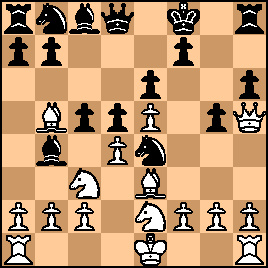
click for larger view10... cxd4
10...Qa5 is arguably best. But Reggio, in his commentary, suggested that 10...Qa5 would have been a losing blunder. But his analysis was ludicrous: 10...Qa5 11. 0-0. Now Black looks OK after 11...BxN. But Reggio assumes that Albin here would play the horrible 11...NxN? In that case, White can win with 12. bxN. But Reggio here has White blundering with 12. NxN? This appears to allow Black to win after 12...BxN 13. bxB QxB and now if 14. Bxg5?! (14. Rab1 Qa6 is not much better for White) the game could continue 14...Qb2! 15. Bxh6+ Ke8 16. Rac1 Nc6 and Black with a piece for two pawns should win. All in all, very doubtful commentary by Reggio. Hard to understand why the Tournament Book decided to have him annotate this game. 11. Bxd4

click for larger view11... a6?
Black now should be fine with 11...Qa5. The text, by contrast, should have landed him in hot water. 12. Bd3 Nc6

click for larger viewNow with 13. BxN NxB 14. NxN dxN, as given by Reggio, should leave White with excellent winning chances. But here Reggio has White playing 15. Rd1 and the game continuing 16...Qd7 16. 0-0 with White for choice. But White would be better still with 15. Nde2 instead of Reggio's suggested 15. Rd1. But all of the above analysis turned out to have no relevance to the actual game in which Reggio played: 13. 0-0?!
Was this an intended sacrifice by Reggio? It loses a piece. White now gets an attack, but a piece is a piece: 13... NxB
14. NxN NxN
This left:

click for larger viewNow 15. bxN runs into an unusual Bishop fork: 15...Bxc3 and Black wins. Did Reggio overlook this? Or did Reggio want to play this wild position with the attacking: 15. f4!
Surely the best chance for White, and perhaps a difficult move to assess over the board. Perhaps Tahl might have tried this--but he would have followed up much better than did Reggio. As will be seen, the resulting position--whatever its theoretical merits--proved too difficult for Reggio and Albin. The position after 15. f4 was: 
click for larger viewNow Albin had to make a tough choice:
15... g4!
15...Qe8 is the defensive move, but the double-edged text is--after long examination by me--is strongest. This left the following extremely difficult position: 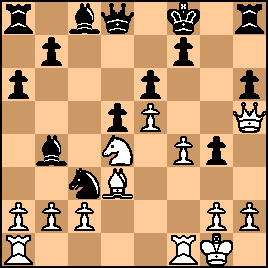
click for larger view |
|
Jan-02-25
 | | KEG: Post III
The theme for most of the rest of the game was whether Reggio could generate an attack sufficient to compensate for the list minor piece: 16. Kh1
When I first played over this game, I thought the text was a mistake and that White should now sac the exchange with 16. bxN Bxc3 17. Nb3 BxR 18. RxB Qb6+ 18. Kh1, but I later decided that this gives Black the opportunity to play 18...g3 etc. I eventually decided that White must get his King off h1 and leave himself the option of a later Rg1. Actually, no move by White is terribly attractive here, but I begrudgingly decided Reggio's move was the best of a bad lot. 16... Nb5
In my initial thinking, I concluded that Black would have a near win with 18...Ne4. The text may in fact be as good or better, though it does allow White some relief by trading Knights, the position now being: 
click for larger view17. Ne2?
Given White's need to attack to justify his piece sacrifice, playing 17. NxN is counter-intuitive. But nonetheless 17. NxN axN 18. Bxb5 was White's best chance here, especially since the text provided Albin with a powerful potential retort. 17... Bc5?
This natural-looking move misses Black's strongest line: 17...f5! 18. exf6 e.p. Qxf6 19. Qxg4 Rf8 after which--still a piece ahead--has a dangerous counter-attack of his own. Black's inferior move left: 
click for larger viewNow Reggio would retain some chances with 18. Ng3. But: 18. c3?
Now 18...f5 is very strong for Black, but...
18... Bd7?
19. Ng3
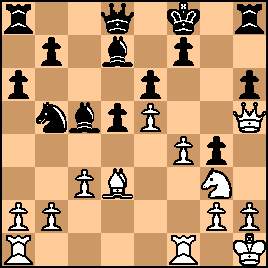
click for larger viewNow, get again, Black appears to have excellent winning chances with 19...f5. But... 19... Qe7
20. Qxg4 Ke8
Yet again I changed my mind here, since I initially thought the text wimpy. But I later decided that letting the Black King run to safety was probably the better part of valor. 21. Nh5

click for larger viewReggio later stated that he (White) had now "arrived at an excellent position." This is a bizarre comment, given that White is still down a piece. White's attack and Black's unsettled King-position may give White some compensation, but I suspect most player would much prefer to be Black here. 21... Kd8
Continuing the King's march to safety.
22. Nf6 Nc7
22...h5 was worthy of consideration.
23. b4 Ba7

click for larger viewBlack's position certainly looks ugly, but (sorry to sound like a broken record) he IS still a piece up. White does have counter-chances and the game is hardly an easy win for Black. Beginning here, however, and perhaps because of the approaching move-30 time control, play became very sloppy by both sides.Thus, as will be seen, what occurred from here in the game did not resolve the question of whether Black should be able to win from the diagrammed position. |
|
Jan-03-25
 | | KEG: Post IV
24. c4
White must attack. 24. f5 is probably even stronger. 24... Ne8?
This should have let Reggio off the hook. White is still on top with 24...Bc6 (avoiding the trade) or 24...dxc4 25. NxB
Of course. It left with White to play:
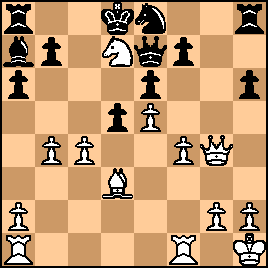
click for larger view25... QxN?
After this wooden re-capture, it is now White (Reggio) who had the chances: 
click for larger view26. cxd5?
Another thoughtless capture (perhaps induced by time pressure). White would have had real winning chances with 26. f5. Now Black is fine if he makes the obvious recapture (26...exd5). But: 26... h5?
Perhaps thinking this was a clever intermediate move. But now the position was: 
click for larger viewHere Reggio could have seized the edge, and even have serious winning chances, with: 27. Qg5+. But: 27. Qh3?
Now Albin could breathe and--still holding a extra piece--was on balance probably at least even: 27... exd5
28. Bf5
The only way to continue the attack.
28... Qe7
29. Rfd1 Nc7
All this left:
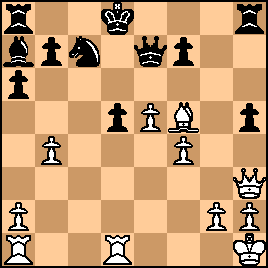
click for larger viewDespite still being a piece down, White appears to have sufficient compensation with 30. Rac1. 30. Be4 is also probably OK. But one more move needed to be made before the move-30 time control was reached. This proved to be a problem for both players: 30. Qc3?
Now Albin had good winning chance with 30...Rh6. But, perhaps also low on time, Albin played: 30... d4?
Perhaps Albin thought this would create forcing lines. But with the d-pawn pinned, suddenly Reggio was very much back in the game, the position now being: 
click for larger viewWith the time control passed, one might expect the players would get a grip on this still very complicated position. But as I will discuss in my next post, play on both sides now degenerated. |
|
Jan-03-25
 | | KEG: Post V
31. Rac1
Reggio now had serious compensation for the lost piece, but he had to keep up the pressure on Black. 31. Qf3 (rather than waiting for his next move to do this) was arguably even stronger than the text. 31... Rh6
31...Ne6 or 31...Rb8 were perhaps slight improvements on the text. 32. Qf3
32. Be4, 32. Qg3, and/or 32. h3 were other possibilities. 32... Rb8
33. a3
33. Be4 was a better way to continue to try to turn the screws on Black. 33... Ke8!
Time to retrace the earlier steps of his prior King stroll. This left: 
click for larger view34. Rc2?
White had no time for this. Better was 34. Re1 or maybe 34. Bd3 34... Kf8?
It is understandable that Albin wanted to get his King out of Dodge. But he here missed the very strong 34...Nb5. 35. Rdc1 Bb6
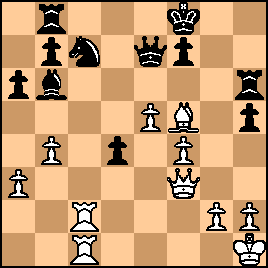
click for larger view36. Be4 Ne8?
Still playing scared. 36...Rd8 supporting the d-pawn was much stronger. 37. h3 a5
37...h4 was worth a look.
38. b5
Allowing Black to dis-connect his Queen-side pawns. 38. Rc4 or even 38. bxa5 were better. 38... a4!
Of course.
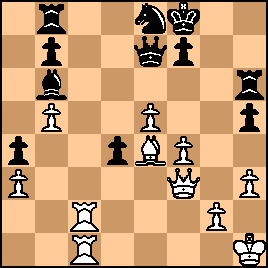
click for larger view39. Rc4 Qd7?
Putting his head in the sand and allowing White to snatch another pawn. 39...Rd8 or 39...Nc7 would create compensating threats to the White pawns. This left: 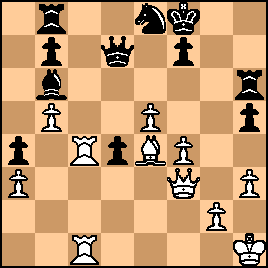
click for larger view40. f5?!
White's attack on the King-side was of course important, but a pawn is a pawn, so 40. Rxa4 was probably most prudent. 40... f6
Probably best, but it allows the White e-pawn to advance. 
click for larger view41. Qf4?
With the move-45 time control approaching, Reggio missed what was probably his last legitimate chance to save the game with 41. e6. Among other things, the text allowed Albin to play the following defensive move: 41... Rh7!

click for larger viewDespite his weak 41st move, Reggio still had at least practical chances in the still very complicated position. But from here, as I will discuss in my next post on this game, Reggio's play completely collapsed and he was soon wiped out by Albin. |
|
Jan-03-25
 | | KEG: Post VI
42. exf6?
An astonishingly bad move after which any even practical chances to save the game were gone. Reggio was a piece down. To throw away his primary weapon (his potentially protected passed e-pawn) was equivalent to resignation. True, he now gets a passed f-pawn. But this was clearly not going to save the day for White. 42... Qd6
43. Qg5
I have no ideas worth sharing for White now.
43... Qxf6

click for larger view44. Qf4
Trading Queens was obviously hopeless for White. 44... Qd6
45. Qh4
If Reggio wanted to play on, 45. Qg5 or 45. Qd2 were probably better options. 45... Bc7

click for larger view46. Kg1?
Hopeless. 46. g3 was the only hope to prolong the game. 46... Qh2+
47. Kf1
Another wretched effort by Reggio (47. Kf2 was "better," to the extent that even mattered any more). The text left the position as: 
click for larger view47... Qf4+
This forces a trade of Queens and thus leaves White without hope. But the really nasty move by White here was 47...Bg3 after which White gets annihilated. 48. QxQ BxQ
49. Rd1 Be3

click for larger view50. Rxa4
Why not? At least now White gets (at least for a while) two pawns for the lost piece. 50... Nd6
51. Bd3 h4
51...Rc8 was probably faster.
52. b6 Rf7
53. Ra5 Kg7
54. Rd5
It seems obviously better to get the White King off the f-file; not that this would save the game. 54... Nxf5
With the White King on the f-file, Black could afford to do this. 55. BxN Rbf8
56. Ke2 RxB
57. RxR RxR

click for larger view0-1
To play on further would be pointless. |
|
|
|
|





